Charles Marville: Photographer of Paris
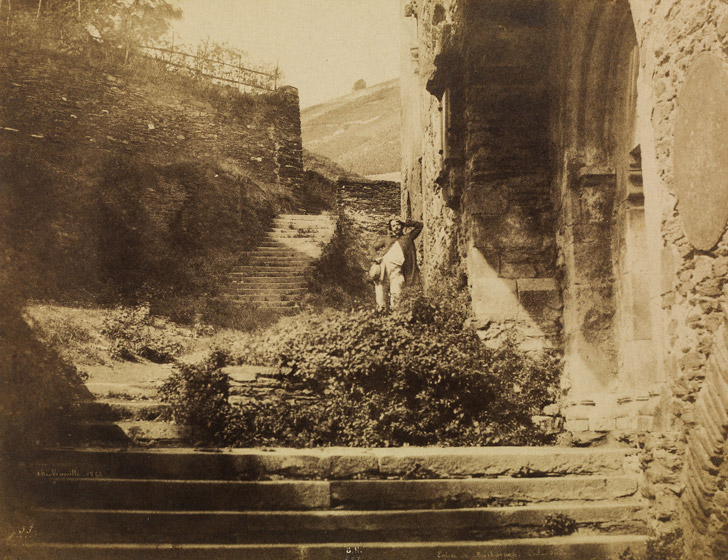
In 1853 and 1854, Marville traveled throughout Germany making landscapes, cityscapes, and architectural studies that were published in an album titled Les Bords du Rhin (The Banks of the Rhine). Marville made this self-portrait in the tumbled-down ruins of the Werner Chapel in Bacharach, a town along the Rhine. These Gothic ruins were a popular subject of travel literature and illustration in the 1830s and 1840s.
Church of Bacharach, Southern End, 1854
salted paper print from paper negative
Bibliothèque nationale de France, Paris
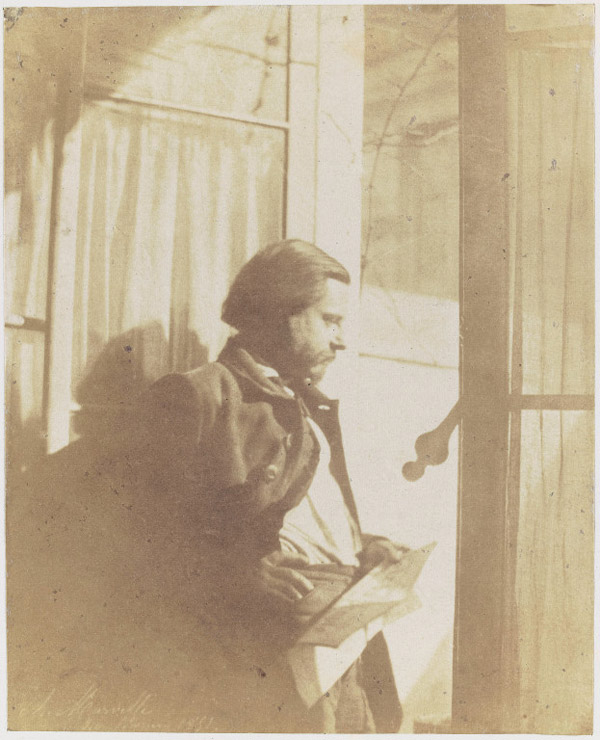
In this early self-portrait, Marville stands in a flood of light at the window of his studio in the heart of the city. Holding what is presumably one of his photographs, Marville assumes the thoughtful and focused air of a sophisticated connoisseur.
Self-Portrait at a Window, February 20, 1851
salted paper print from paper negative
Musée d’Orsay, Paris
Image © Réunion des Musées Nationaux / Art Resource, NY

Views of Paris with the bridges of the Seine were very popular in mid-19th-century France, thanks in part to the expanding genre of illustrated travel literature. Marville’s photograph catalogues numerous delightful details, from the sacks on the wharf awaiting transport and the scaffolding on the Louvre at left, to the piles of quarried stone by the Institut de France (a scholarly society) at right. Although panoramic cameras were available at the time, Marville made this photograph by joining two negatives and printing them together as a single seamless image.
The Seine from the Pont du Carrousel, Looking toward Notre Dame, c. 1854
salted paper print from paper negative mounted on paperboard
National Gallery of Art, Washington, Patrons' Permanent Fund

The deep shadows framing this doorway at Chartres cathedral create spatial depth and draw the gaze toward a tiny detail: a small lamp hanging in the center of the open doorway. Marville’s keen ability to harness the play of light, especially against three-dimensional surfaces, made him a sought-after photographer of architecture and sculpture. This print was formerly in the collection of the sculptor Adolphe-Victor Geoffroy-Dechaume, who contributed to the restoration of Chartres in the 1850s and who frequently hired Marville to photograph his work.
South Portal, Chartres Cathedral, 1854
salted paper print from paper negative
Lent by The Metropolitan Museum of Art, Purchase, Jennifer and Joseph Duke Gift and The Horace W. Goldsmith Foundation Fund, through Joyce and Robert Menschel, 2000
Image © The Metropolitan Museum of Art

Starting in the 1830s, a heightened awareness of the precarious condition of France’s medieval monuments (many of which had been damaged during the French Revolution) fueled vast restoration projects all across the country. Although Marville worked closely with Viollet-le-Duc, who oversaw renovations to Notre Dame, this view of the cathedral’s spire with the city spread out below was most likely commissioned by the company that manufactured the leadwork and many of the decorative ornaments on the cathedral’s roof.
Spire of Notre Dame, Viollet-le-Duc, Architect, 1859–1860
albumen print from collodion negative
The AIA/AAF Collection, Prints and Photographs Division, Library of Congress, Washington, DC

The Roofs of Notre Dame, from the Gallery of Towers, 1859–1860
albumen print from collodion negative
The AIA/AAF Collection, Prints and Photographs Division, Library of Congress, Washington, DC

Sky Study, Paris, 1856–1857
albumen print from collodion negative
Lent by The Metropolitan Museum of Art, Gilman Collection, Purchase, Ann Tenenbaum and Thomas H. Lee Gift, 2005
Image © The Metropolitan Museum of Art

Sky Study, Paris, 1856–1857
albumen print from collodion negative
Lent by The Metropolitan Museum of Art, The Horace W. Goldsmith Foundation Fund, through Joyce and Robert Menschel, 1987
Image © The Metropolitan Museum of Art

Musée Carnavalet, Paris, The Emperor’s Kiosk, Bois de Boulogne, 1858–1860
albumen print from collodion negative
Musée Carnavalet / Roger-Viollet
Image © Musée Carnavalet / Roger-Viollet

Longchamps Windmill, Bois de Boulogne, 1858–1860
albumen print from collodion negative
Musée Carnavalet, Paris
Image © Musée Carnavalet / Roger-Viollet
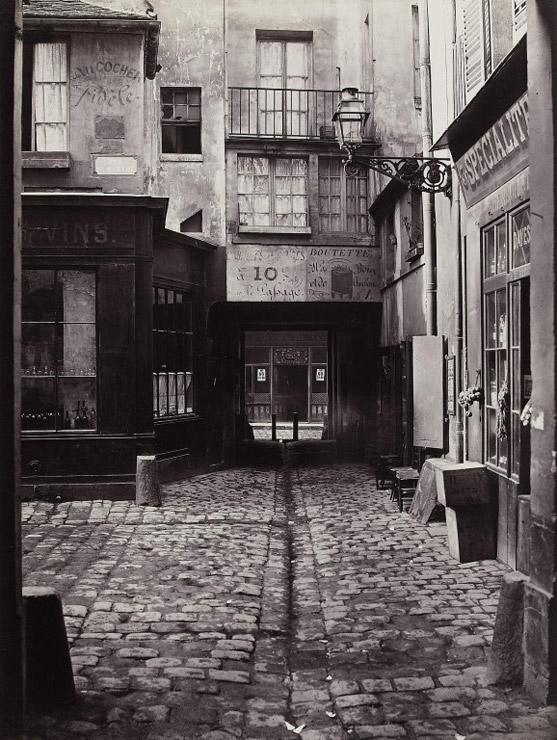
The motif of an opening at the back of the picture appears in many compositions, and, like the small streets and alleys themselves, serves to connect the immediate foreground subject with other spaces just at the edge of the camera’s reach.
Passage Saint-Benoît (sixth arrondissement), 1864–1867
albumen print from collodion negative
Musée Carnavalet, Paris
Image © Musée Carnavalet / Roger-Viollet

This view, looking toward the Palace of Justice, was made shortly before the rue de Constantine was destroyed and replaced with a wider avenue. Just visible in the lower left corner is a poster advertising a new invention, retractable umbrellas “in the American style.”
Rue de Constantine (fourth arrondissement), 1866
albumen print from collodion negative
Lent by The Metropolitan Museum of Art, The Horace W. Goldsmith Foundation Fund, through Joyce and Robert Menschel, 1986
Image © The Metropolitan Museum of Art

The trickle of shimmering liquid on the paving stones is not what it seems. The streets of Old Paris were notoriously filthy and frequently full of raw sewage, prompting one writer to observe that “a stream of black mire constantly runs through many of the streets . . . . often becoming a rapid torrent. It requires no inconsiderable agility to leap across it, and the driver of the cabriolet delights in plentifully splattering its black and disgusting contents on every unfortunate pedestrian.”
Rue de la Bûcherie (from the cul de sac Saint-Ambroise) (fifth arrondissement), 1866–1868
albumen print from collodion negative
National Gallery of Art, Washington, Horace W. Goldsmith Foundation through Robert and Joyce Menschel

Bas-reliefs de l’Hôtel Colbert (fifth arrondissement), 1862 – 1866
albumen print from collodion negative
Musée Carnavalet, Paris
Image © Musée Carnavalet / Roger-Viollet

Passage de l’Opéra (Galerie de l’Horloge) (ninth arrondissement), c. 1868
albumen print from collodion negative
Musée Carnavalet, Paris
Image © Musée Carnavalet / Roger-Viollet

The Passage de l’Opéra, named for the nearby Opéra Le Peletier, was inaugurated in 1823. The passage was formed by a pair of parallel two-story galleries for shops, cafés, a restaurant, and a nightclub, as well as apartments on the top floor. Marville photographed both galleries (see the previous photograph) and the glass-roofed corridor that connected them—the view pictured here. The Passage de l’Opéra disappeared in 1926 on the completion of boulevard Haussmann.
Passage de l’Opéra (from the rue Le Peletier) (ninth arrondissement), c. 1868
albumen print from collodion negative
Musée Carnavalet, Paris
Image © Musée Carnavalet / Roger-Viollet

The Bièvre River (fifth arrondissement), c. 1862
albumen print from collodion negative
Joy of Giving Something, Inc.
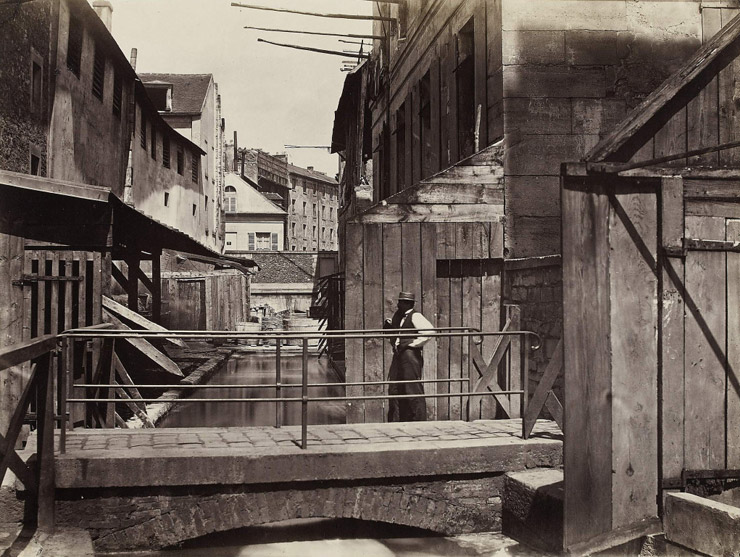
Banks of the Bièvre River at the Bottom of the rue des Gobelins (fifth arrondissement), c. 1862
albumen print from collodion negative
Musée Carnavalet, Paris
Image © Musée Carnavalet / Roger-Viollet

The Butte des Moulins (literally “windmill hill”) was a small hill—part natural, part built up—that had existed in Paris since ancient times. Dotted with windmills, it was a working-class neighborhood dominated by small trades until the mid-1870s, when its population was cleared and the hill was leveled to construct the avenue de l’Opéra—which would become widely celebrated as the most glamorous street in Paris.
Construction of the avenue de l’Opéra: The Butte des Moulins (from the rue Saint-Roch), December 1876
albumen print from collodion negative
Musée Carnavalet, Paris
Image © Charles Marville / Musée Carnavalet / Roger-Viollet

Construction of the avenue de l’Opéra, December 1876
albumen print from collodion negative
Musée Carnavalet, Paris
Image © Musée Carnavalet / Roger-Viollet

Urinal, Jennings System, plateau de l’Ambigu, 1876
albumen print from collodion negative
Musée Carnavalet, Paris
Image © Musée Carnavalet / Roger-Viollet

Hôtel de la Marine, 1864–1870
albumen print from collodion negative
National Gallery of Art, Washington, Diana and Mallory Walker Fund

Arts et Métiers (Ancien Modèle), 1864
albumen print from collodion negative
Lent by The Metropolitan Museum of Art, Purchase, Alfred Stieglitz Society Gifts, 2007
Image © The Metropolitan Museum of Art

This desolate space was in the process of being transformed into one of the most magnificent boulevards in Paris, cutting a long vista between the Panthéon and the July Column, a monument commemorating the revolution of 1830. In Marville’s photograph, the column appears as a mirage hovering in the middle distance, separated from the viewer by scarred earth, half-demolished buildings, and a team of complacent horses awaiting their orders.
Boulevard Henri IV (from the rue de Sully) (fourth arrondissement), c. 1877
albumen print from collodion negative
Musée Carnavalet, Paris
Image © Musée Carnavalet / Roger-Viollet

Rue des Saules (18th arrondissement), c. 1877
albumen print from collodion negative
Musée Carnavalet, Paris
Image © Musée Carnavalet / Roger-Viollet
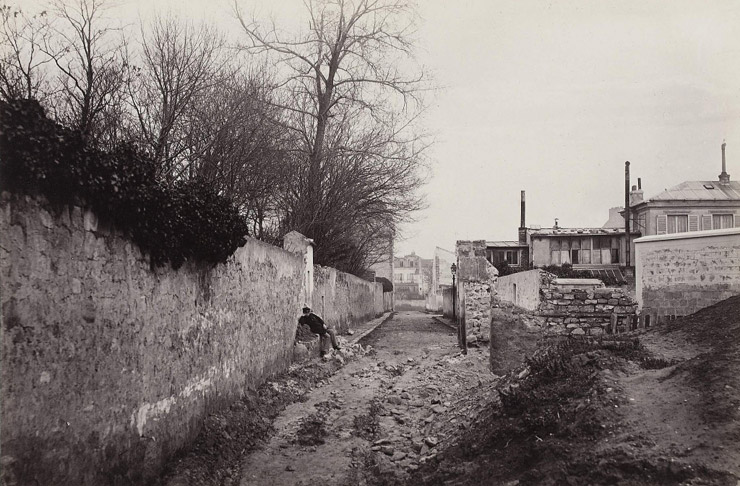
With their yawning, half-built foregounds, struggling vegetation, and inert figures (such as the one posed against the wall), Marville’s photographs of the periphery of Paris convey the sense of neighborhoods in transition. Even as the city trumpeted its glories at the 1878 Universal Exhibition, the outskirts of Paris became a familiar subject in art and literature, serving as convenient shorthand for the dislocation and exile many Parisians experienced in their changed city.
Avenue du Commandeur (from the rue d’Alésia) (14th arrondissement), 1877–1878
albumen print from collodion negative
Musée Carnavalet, Paris
Image © Musée Carnavalet / Roger-Viollet